- Pepsi stock is looking cheap, but under the hood, things are a bit shaky
- The company has gotten into trouble, but I argue why its headwinds are temporary
- I break down Pepsi’s fundamentals and explain why it might deserve a place in your portfolio…
“Elevator Pitch” Overview
PepsiCo is a global snacks-and-beverages powerhouse with nearly $92 billion in FY2024 revenue. Its valuation is showing the biggest discounts in decades. Why? Management stumbled by hiking prices aggressively to offset inflation. That helped profits, but hurt volumes—especially in North America. Now they’re cutting costs and trying to reignite growth. With world-class brands and a vertically integrated supply chain, can Pepsi get back on course?
What does the company actually do?
PepsiCo isn’t just soda. In fact, most of its sales come from salty snacks—Lay’s, Doritos, Cheetos, etc.—plus a smaller segment of convenient foods (Quaker, Cap’n Crunch,…). Beverages like Pepsi and Gatorade make up the rest.
Unlike Coca-Cola, which licenses and outsources much of its operations, Pepsi runs a vertically integrated empire—owning production, logistics, and even a vast direct-store delivery (DSD) network across 200+ countries. This makes the business more asset-heavy (with $58B in PPE vs. Coca-Cola’s $20B), but also gives Pepsi more control.
In FY2024, 58% of revenues came from food, and 42% from beverages, with Frito-Lay as the main profit engine, generating $24.8B in sales and $6.5B in profit. You can see a detailed overview here:

To be clear, Pepsi is a boring, mature business. But that’s where the opportunity lies in plain sight.
Why should investors care now?
Pepsi is in the middle of a turnaround. Inflation jacked up production costs, which Pepsi responded to with steep price hikes—double-digit in some quarters. That helped offset the pressure on earnings, but volumes fell:
- Total volume: -2% in FY2024
- North America beverages: -3.5% YoY
- Frito-Lay: -2.5% YoY
While price hikes offset some EPS impact, a consumer business has to sell, especially one with slim margins.
Pepsi now faces two key challenges:
- Reviving growth in a tougher economic environment, with consumers opting for cheaper alternatives and input costs still rising.
- Adapting to shifting preferences: low-sugar, functional, and “clean label” brands are winning. New players like Olipop are stealing share and relevance. Pepsi must adapt to consumers who realized 40 grams of sugar in their drink is not great.
All of this, plus being an asset-heavy business in an uncertain macro climate, has created the widest valuation gap between Pepsi and Coke in decades.
The turnaround hinges on management executing better and sentiment improving, which could lead to margin re-rating closer to the historical average.
Trump Tariffs: A New Headwind
To add salt to the wound, Trump’s tariffs disproportionately disadvantage Pepsi compared to Coca-Cola. Why?
- Pepsi produces concentrate in Ireland (to save on taxes), now subject to a 10% tariff, while Coca-Cola manufactures in the U.S., mostly avoiding this hit.
- Both will feel the pain of 50% aluminum tariffs, as cans make up ~25% of their packaging. Coca-Cola is already shifting to PET bottles. But Pepsi hasn’t given us much direction yet.
Fun Fact: Did you know that Trump installed a Diet Coke button on his desk in the Oval Office? Twice.
The tariff war comes at a bad time for Pepsi, causing investor sentiment to fizzle out. But none of Trump’s tariffs are final, with Pepsi already lobbying for an exemption.
Latest Earnings Show Signs Of Success
Despite gloomy sentiment, Pepsi surprised to the upside:
- Beat expectations
- Volume growth in PFNA and EMEA
- Improving trends in APAC and IB
- Slower deceleration in LATAM
Pepsi guided for low-single-digit organic growth and flat EPS for the year. Doesn’t sound exciting—but it was enough to spark a +7% rally in one day.
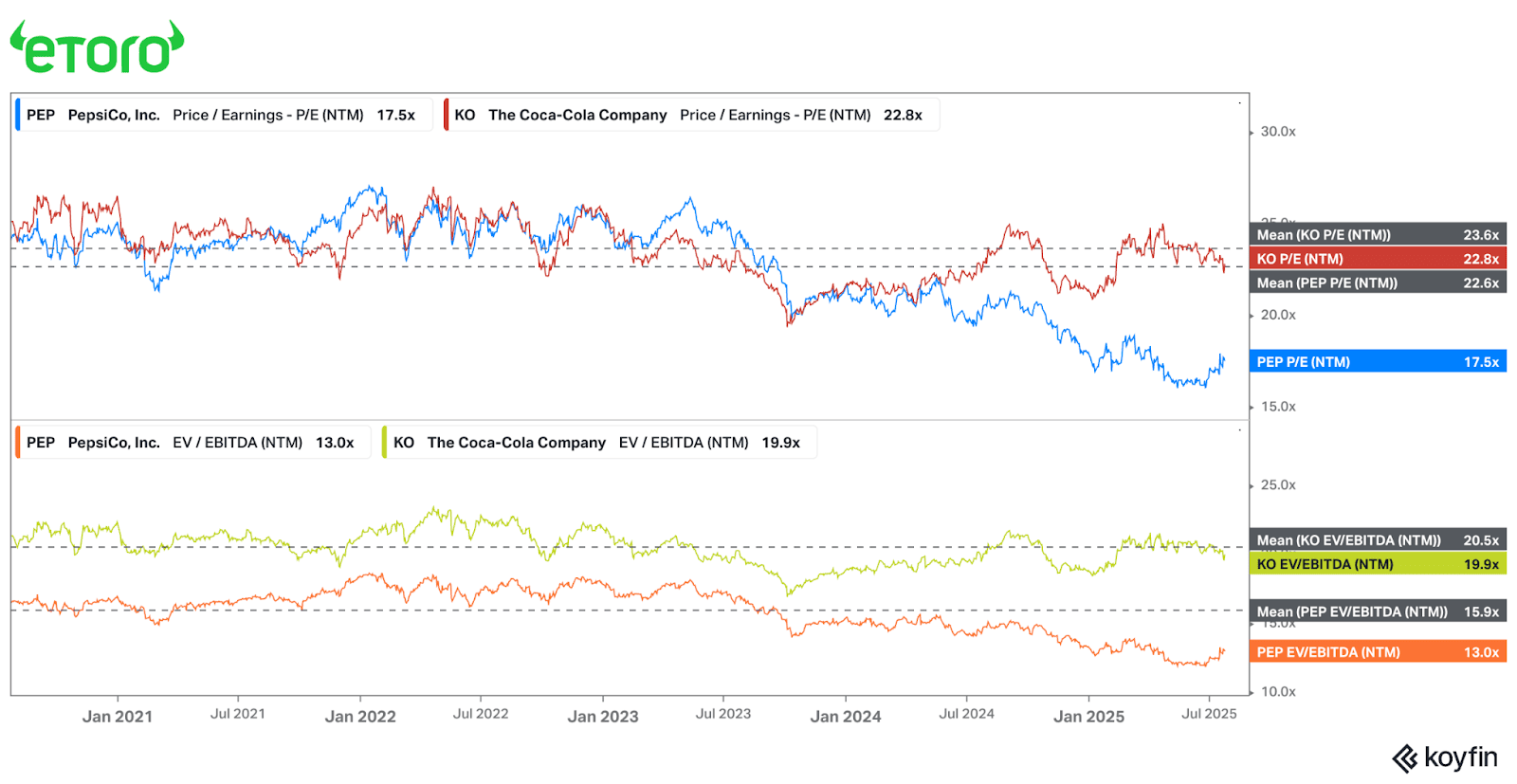
If this momentum holds, and tariff pressure eases, there’s a potential 10–20% upside as valuations revert closer to their long-term average. That’s assuming that Pepsi continues to trade cheaper than Coca-Cola for obvious reasons.
Financial Health Check
Pepsi has a strong balance sheet, though it carries more debt than some peers due to acquisitions and shareholder returns. It maintains an investment grade credit rating and has enough cash flow to easily cover its financial obligations.
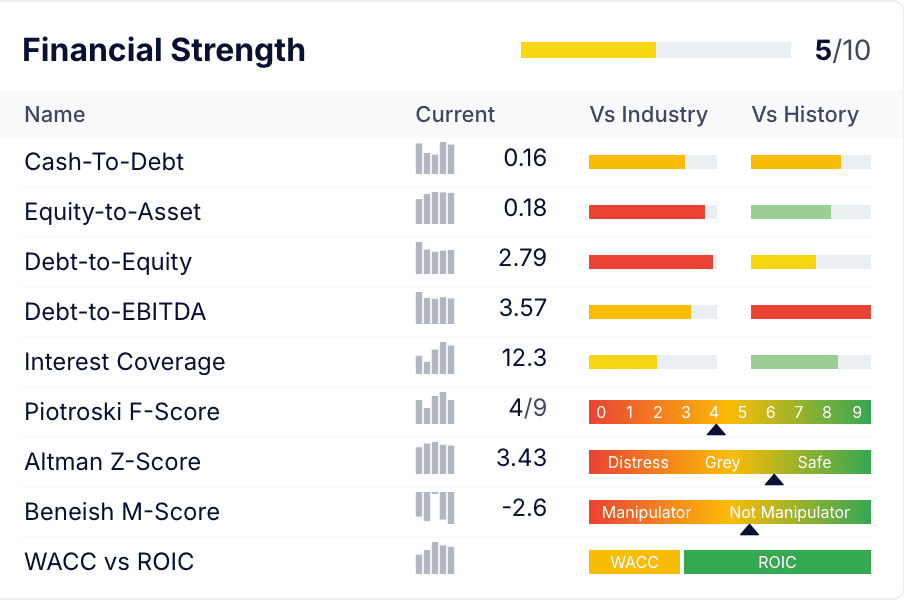
Nothing alarming here.
Moat Analysis
The moat, or competitive advantage, is the most important part of a business for value investors, and Pepsi’s moat is wide and deep.
| Moat pillar | Evidence |
| Brand Power | Pepsi, Lay’s, Doritos, Gatorade, Quaker, and more enjoy strong customer loyalty and trust and rank among the world’s top brands. |
| Vertical Integration | Pepsi owns a massive direct-store-delivery (DSD) system, controlling the route from production to retail shelf. This ensures prime shelf placement and rapid replenishment. |
| Economies of Scale | PepsiCo’s economies of scale allow it to negotiate input pricing and give it massive marketing budgets.
Strong brands drive volume –> scale lowers costs –> funds marketing and innovation –> further strengthens brands |
Even as consumer preferences shift, Pepsi’s scale and shelf dominance are tough to beat.
Industry & Competitive Landscape
Pepsi and Coca-Cola dominate their industries. In 2024, they controlled ~18% and ~21% of the US beverage market. However, Coca-Cola has a market share advantage overseas.
Comparing the leaders latest earnings, Coca-Cola guided for 3% EPS growth while Pepsi reaffirmed its target of flat EPS this year, justifying the valuation gap.
The industry is now characterized by a rising share of health-oriented brands and consumer preferences for healthier snacks. Still, while Soft-drink volumes fell 3% globally in 2024, salty snacks grew 6,4%, giving Pepsi the upper hand thanks to a broader offering.
All of the factors we discussed in this analysis are short-term, solvable things that management has already set its sights on. Yes, the valuation gap makes sense to a degree, but the market appears overly bearish.
Capital return to shareholders
Pepsi’s capital return is centered around steadily growing dividends. The stock currently yields a hefty 3,95% dividend that has grown at a pace of 7,1% over the past 5 years.

As you can see in the yellow box, there’s no need to fear for the dividend. Pepsi is one of the famed dividend kings, or companies that have paid dividends for more than 50 years.
Bull vs Bear case
| View | Key Points | Upside / Downside |
| Bull case | – Short-term headwinds are priced in
– Management adapts to new consumer trends – Tariffs get rolled back or softened – Stable dividend + multiple expansion |
10–20% upside |
| Bear case | – Structural volume declines
– Failure to innovate – Tariffs pressure costs – Health trends erode core business |
-10 to -15% downside |
Valuation & Street view
Pepsi and Coca-Cola have long traded in sync. Historically, investors flocked to Coca-Cola when the industry was facing economic or political headwinds, thanks to its leaner, beverage oriented operations. Such a divergence in the valuation as we are seeing now is unprecedented over the last 20 years.
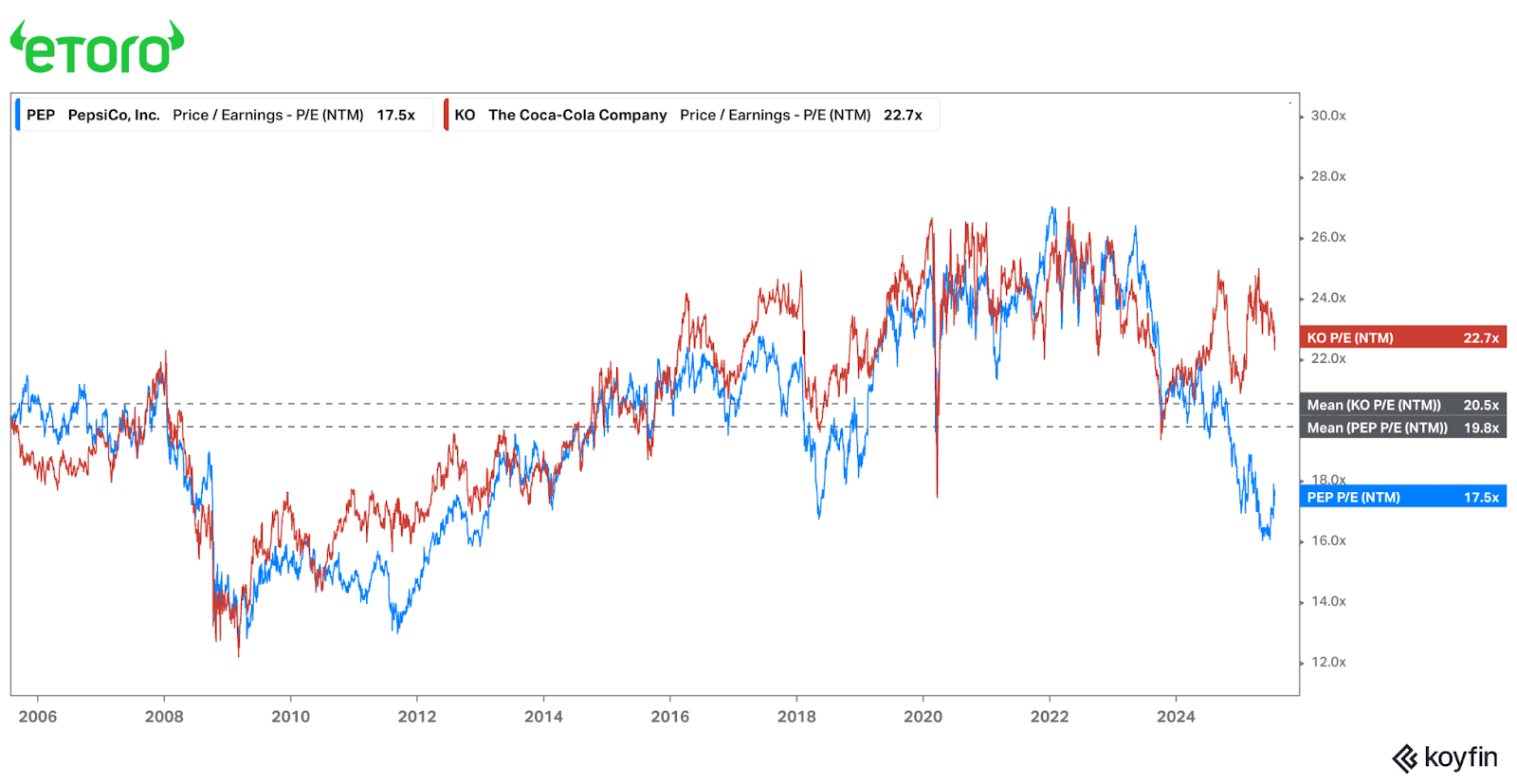
While Pepsi is facing headwinds again, and investors are likely worried about the potential impact of tariffs and macroeconomics, these are short-term headwinds that can be sorted out. In such a case, Pepsi stock could see multiple expansion on the back of the almost 4% dividend and flat EPS this year.
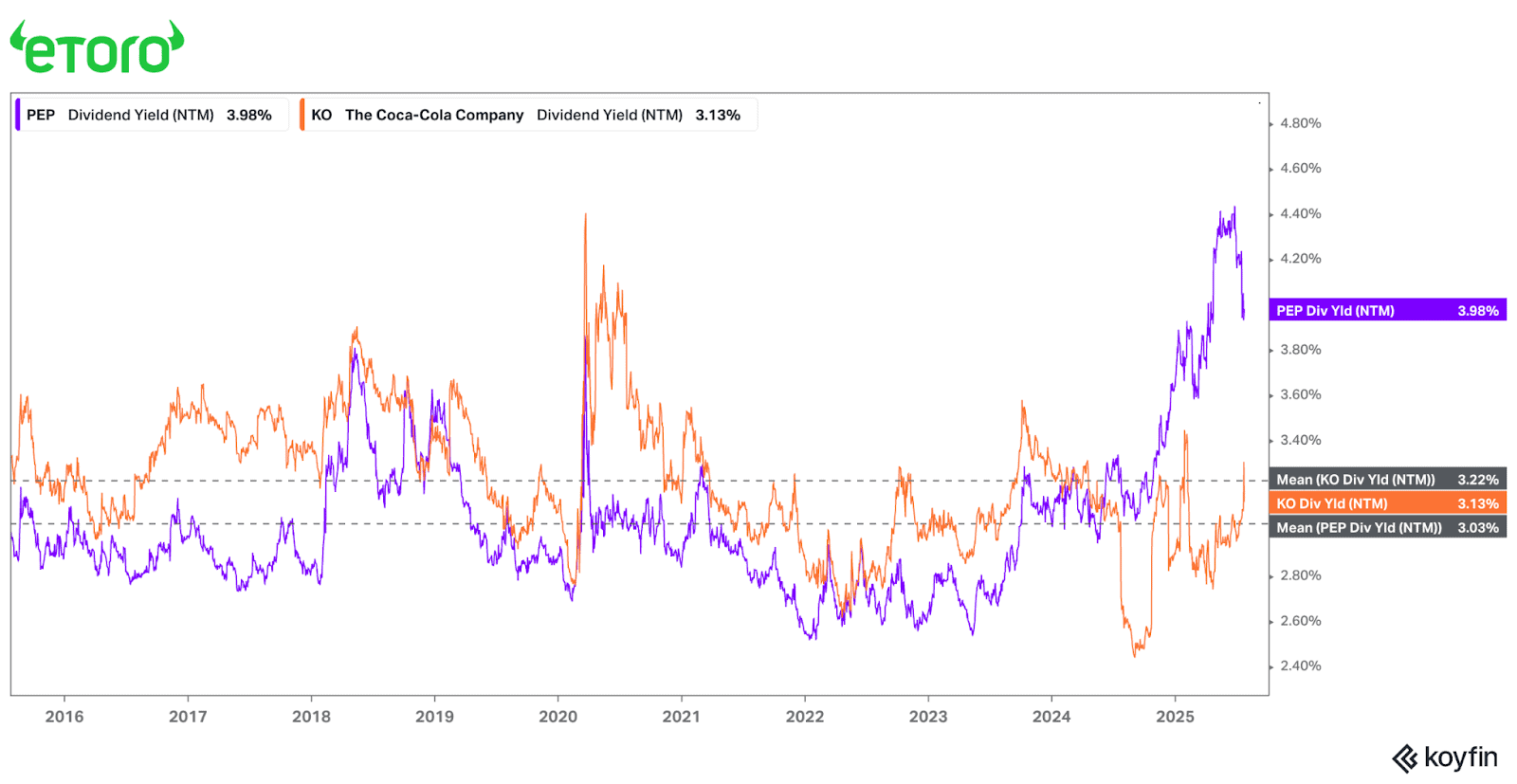
The dividend yield of the two stocks also clearly shows that Pepsi is relatively undervalued. A reversal to the mean indicates a further double-digit upside from here, if the momentum from the last earnings report keeps up.
You either pay for growth, or you pay for boredom. Pepsi is a boring business, and in a market that’s chasing growth at all costs, it’s easy to overlook.
Will pepsi grow 100%? Probably not, but if management can steer the company in the right direction in the coming quarters, you’re looking at easy growth potential from here.
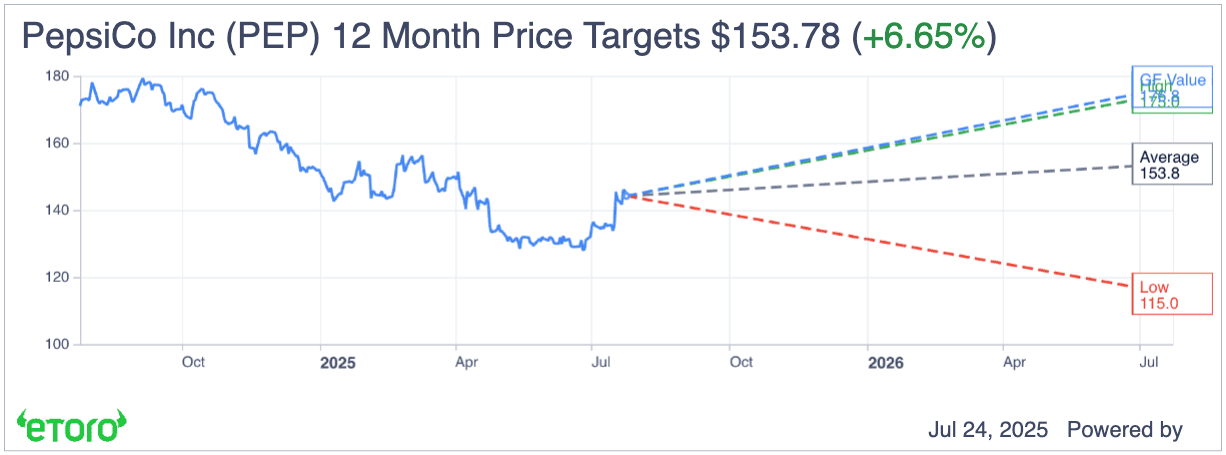
Wall Street has a diverging view of the stock, with the indicated 12-month upside at 6,65% while analysts expectations have a massive range. Again, showing the uncertainty that is being priced in.
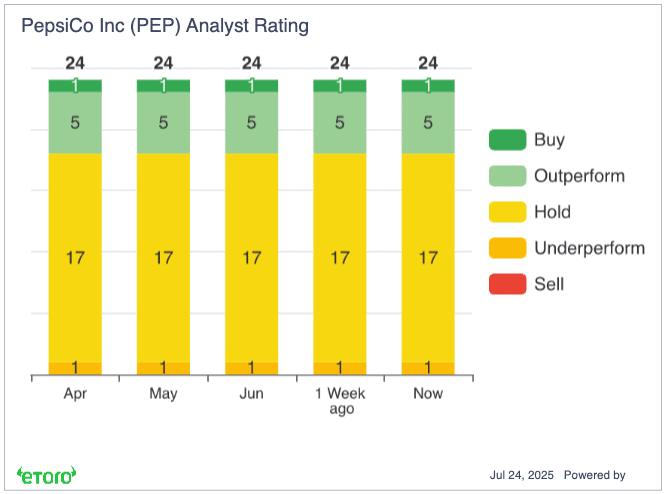
Out of 24 analysts, 17 rate the stock a hold, with 5 expecting it to outperform, and only one analyst in both the “buy” and “underperform” camp.
Bottom-line wrap
While I prefer to drink from the red cans, Pepsi stock might be the smarter pick right now. If management navigates cost cutting, volume expansion and shifting consumer preferences right, I expect 10 to 20% upside in a non-cyclical stalwart that offers stability in choppy waters.
Is PepsiCo a better bet than Cola-Cola today? Share your take by tagging me as @TheDividendFund on eToro or check the PEP ticker to dive deeper.
This communication is for information and education purposes only and should not be taken as investment advice, a personal recommendation, or an offer of, or solicitation to buy or sell, any financial instruments. This material has been prepared without taking into account any particular recipient’s investment objectives or financial situation and has not been prepared in accordance with the legal and regulatory requirements to promote independent research. Any references to past or future performance of a financial instrument, index or a packaged investment product are not, and should not be taken as, a reliable indicator of future results. eToro makes no representation and assumes no liability as to the accuracy or completeness of the content of this publication.



